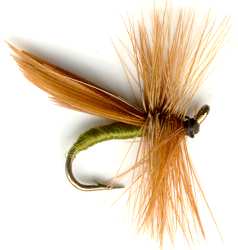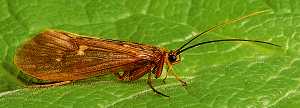The Cinnamon Sedge Caddis Dry Fly
The Cinnamon Sedge Caddis Dry Fly is a good Grannom caddis imitation. In most areas in spring, the first sedge fly of real importance is the grannom.

CADDIS FLY PATTERNS. Hook size 10 12 14 16 18 20 - $US each
The main Grannom Caddis hatch usually lasts for ten days or so, with flies coming off the water from mid morning until late afternoon. The fish tend to ignore small upwinged mayflies when the grannom is on the water. Other sedges are rare at that time so any fly that can imitate the grannom works. My favorite is the the old British classic dry fly Cinnamon Sedge. I have had great success on the chalk rivers of Southern England and in Wales. I was on holiday in Pennsylvania, USA in late April one year and was lucky to fish the grannom hatch. I caught 13 during two hours. A local called the fish 'tiger trout' which is some kind of cross bread trout. I caught all of these fish on top with Cinnamon Sedge dry flies. The smallest trout was 12" and the largest 16". I have found that the grannom larvae are often to be found in greatest concentrations in and around weed beds, but on stony spate rivers the swift glides are usually good places to fish the hatch.
Most adult sedge flies are nocturnal, but the Grannom hatch by day and extend into the evening. They are found in all sorts of waters. After the hatch, errant and unlucky adults fall onto the water, and a dry fly is the right choice. Bankwater downwind or downstream from overhanging trees is a good place to cast your dry. Female grannoms swim or crawl underwater to lay eggs. On moonlit nights a buoyant artificial Cinnamon Sedge dry fly can give great sport

Tan Elk Hair Caddis sedge natural fly The common or slang term ‘sedge’ originates from the fact that adult Caddis flies can often be found clinging to sedge grass near the waters. Sedge/Caddis flies have four wings. The forward pair are normally a little longer than those at the rear. At rest their wings lie close along the body in an inverted V shape. Caddis flies do not have tails but many have long antenna. The Latin name for this group of flies is ‘Trichoptera’ (Greek for 'hairwing'). They pass through four stages in their development; egg, larva, pupa and adult. The eggs are laid by the adult female in large jelly mass, which often floats on the water surface and drift until they stick to some river side vegetation. Some species lay their eggs directly on vegetation
The eggs hatch into larva in about 10-12 days. The Larvae produce a sticky substance and attach what ever material in on the river bed to their body. This offers protection and camouflage. The pupa stage lasts for several days. The fully formed pupa has middle body legs that it uses to swim to the surface to hatch. Some species choose the shore or vegetation to emerge rather than open water where they are easy prey for the trout.
Adult caddis flies vary in size. Their bodies are rather drab in color from gray, brown to green. The wings are mottled, patterned or pale and vary in colour from black, brown to gray. If the fish are not taking fly patterns of natural colors try a brightly colored attractor pattern of the correct shape. Most hatch early or late evening. Some hatch in the afternoon and some at night. The fish have two chances of catching these flies; when they emerge and when they return to lay eggs. Some species have a problem drying their wings and remain on the surface for a considerable time, causing a disturbance. Others that move to shore to hatch fully also cause a disturbance.


